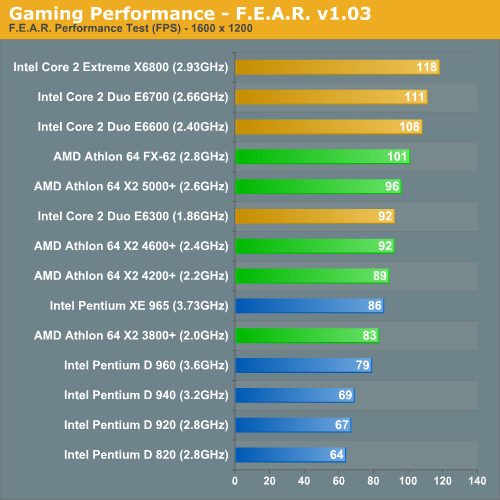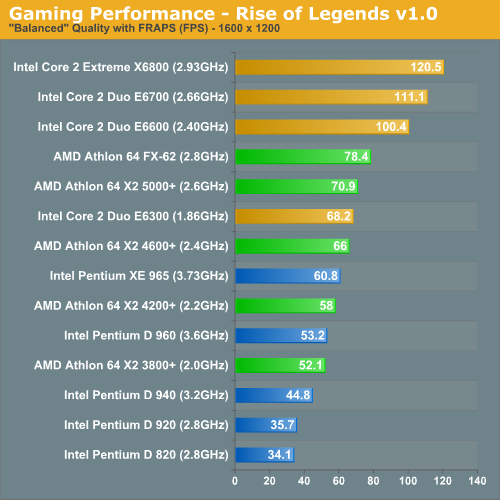Intel's Core 2 Extreme & Core 2 Duo: The Empire Strikes Back
by Anand Lal Shimpi on July 14, 2006 12:00 AM EST- Posted in
- CPUs
Gaming Performance using F.E.A.R. & Rise of Legends
Our F.E.A.R. test should be fairly familiar by now, as it is the built in performance test included with the game. Computer settings were left at "Maximum" while the graphics settings were set to "High" with the resolution cranked up to 1600 x 1200. F.E.A.R. ends up still being more GPU than CPU bound at these settings, even with a pair of X1900 XTs at its disposal, but we do see some separation among the processors:

The top three spots still go to the top three Core 2 CPUs, with the E6300 falling around the level of the X2 4600+. A trend that we've been seeing all throughout this review is that the performance of these CPUs effectively falls into three groups: Core 2 processors at the top, Athlon 64 X2s in the middle and Pentium D at the very bottom of the charts. In a sense that's the easiest way to classify these three groups of processors: if you want the fastest it's Core 2, mid-range goes to the Athlon 64 X2 and if you don't like good performance there's always the Pentium D.
Rise of Legends is a newcomer to our game benchmark suite and what an excellent addition it is. This Real Time Strategy game looks very good and plays well too; it serves as good filler until the next Command & Conquer title eventually arrives for those looking for a RTS fix. We ran with the resolution set to 1600 x 1200 and the graphics settings set to the medium defaults. We recorded a custom playback of a 3 vs. 2 multiplayer battle and played it back at 4x speed, recording the average frame rate for 10 minutes of the battle. The 10 minutes we focused on contained a good mix of light skirmishes between opponents, base/resource management with very few characters on the screen and of course some very large scale battles.

As with most RTSes, Rise of Legends is extremely CPU bound. The performance variability between runs was fairly high in this test, mainly because of how disk intensive the playback can get. Differences in performance of up to 5% should be ignored, but the standings are correct - the Core 2 line of processors absolutely demolish the competition: you're looking at true next-generation CPU performance here. The E6300 isn't nearly as impressive when compared to its more expensive siblings, but when you compare it to AMD's lineup it looks very good, especially considering its proposed cost.










202 Comments
View All Comments
code255 - Friday, July 14, 2006 - link
Thanks a lot for the Rise of Legends benchmark! I play the game, and I was really interested in seeing how different CPUs perform in it.And GAWD DAMN the Core 2 totally owns in RoL, and that's only in a timedemo playback environment. Imagine how much better it'll be over AMD in single-player games where lots of AI calculations need to be done, and when the settings are at max; the high-quality physics settings are very CPU intensive...
I've so gotta get a Core 2 when they come out!
Locutus465 - Friday, July 14, 2006 - link
It's good to see intel is back. Now hopefully we'll be seeing some real innovation in the CPU market again. I wonder what the picture is going to look like in a couple years when I'm ready to upgrade again!Spoonbender - Friday, July 14, 2006 - link
First, isn't it misleading to say "memory latency" is better than on AMD systems?What happens is that the actual latency for *memory* access is still (more or less) the same. But the huge cache + misc. clever tricks means you don't have to go all the way to memory as often.
Next up, what about 64-bit? Wouldn't it be relevant to see if Conroe's lead is as impressive in 64-bit? Or is it the same horrible implementation that Netburst used?
JarredWalton - Friday, July 14, 2006 - link
Actually, it's the "clever tricks" that are reducing latency. (Latency is generally calculated with very large data sets, so even if you have 8 or 16 MB of cache the program can still determine how fast the system memory is.) If the CPU can analyze RAM access requests in advance and queue up the request earlier, main memory has more time to get ready, thus reducing perceived latency from the CPU. It's a matter of using transistors to accomplish this vs. using them elsewhere.It may also be that current latency applications will need to be adjusted to properly compute latency on Core 2, but if their results are representative of how real world applications will perceive latency, it doesn't really matter. Right now, it appears that Core 2 is properly architected to deal with latency, bandwidth, etc. very well.
Spoonbender - Friday, July 14, 2006 - link
Well, when I think of latency, I think worst-case latency, when, for some reason, you need to access something that is still in memory, and haven't already been queued.Now, if their prefetching tricks can *always* start memory loads before they're needed, I'll agree, their effective latency is lower. But if it only works, say, 95% of the time, I'd still say their latency is however long it takes for me to issue a memory load request, and wait for it to get back, without a cache hit, and without the prefetch mechanism being able to kick in.
Just technical nitpicking, I suppose. I agree, the latency that applications will typcially perceive is what the graph shows. I just think it's misleading to call that "memory latency"
As you say, it's architected to hide the latency very well. Which is a damn good idea. But that's still not quite the same as reducing the latency, imo.
Calin - Friday, July 14, 2006 - link
You could find the real latency (or most of it) by reading random locations in the main memory. Even the 4MB cache on the Conroe won't be able to prefetch all the main memory.Anyway, the most interesting is what memory latency the application that run feels. This latency might be lower on high-load, high-memory server processors (not that current benchmarks hint at this for Opteron against server-level Core2)
JarredWalton - Friday, July 14, 2006 - link
"You could find the real latency (or most of it) by reading random locations in the main memory."I'm pretty sure that's how ScienceMark 2.0 calculates latency. You have to remember, even with the memory latency of approximately 35 ns, that delay means the CPU now has approximately 100 cycles to go and find other stuff to do. At an instruction fetch rate of 4 instructions per cycle, that's a lot of untapped power. So, while it waits on main memory access one, it can be scanning the next accesses that are likely to take place and start queuing them up. And the net result is that you may never actually be able to measure latency higher than about 35 ns or whatever.
The way I think of it is this: pipeline issues aside, a large portion of what allowed Athlon 64 to outperform at first was reduced memory latency. Remember, Pentium 4 was easily able to outperform Athlon XP in the majority of benchmarks -- it just did so at higher clock speeds. (Don't *even* try to tell me that the Athlon XP 3200+ was as fast as a Pentium 4 3.2 GHz... LOL.) AMD boosted performance by about 25% by adding an integrated memory controller. Now Intel is faster at similar clock speeds, and although the 4-wide architectural design helps, they almost certainly wouldn't be able to improve performance without improving memory latency -- not just, but in actual practice. With us, I have to think that our memory latency scores are generally representative of what applications see. All I can say is, nice design Intel!
JarredWalton - Friday, July 14, 2006 - link
"...allowed Athlon 64 to outperform at first was...."Should be:
"...allowed Athlon 64 to outperform NetBurst was..."
Bad Dragon NaturallySpeaking!
yacoub - Friday, July 14, 2006 - link
""Another way of looking at it is that Intel's Core 2 Duo E6600 is effectively a $316 FX-62".Then the only question that matters at all for those of us with AMD systems is: Can I get an FX-62 for $316 or less (and run it on my socket-939 board)? If so, I would pick one up. If not, I would go Intel.
End of story.
Gary Key - Friday, July 14, 2006 - link
A very good statement. :)